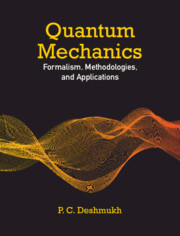Book contents
- Frontmatter
- Dedication
- Contents
- List of Figures
- Foreword
- Preface
- 1 Description of a Physical System
- 2 Path Integral Formulation of Quantum Mechanics
- 3 Probability Tangles and Eigenstates of One-dimensional Potentials
- 4 Angular Momentum
- 5 The Non-relativistic Hydrogen Atom
- 6 Approximation Methods
- 7 The Relativistic Hydrogen Atom
- 8 Quantum Mechanics of Spectral Transitions
- 9 The Many-Electron Atom
- 10 Quantum Collisions
- 11 Introduction to Quantum Information and Quantum Computing
- Appendix A Symmetry of the Hamiltonian
- Appendix B Schrödinger, Heisenberg, and Dirac “Pictures” of Quantum Dynamics
- Appendix C Spherical Harmonics
- Appendix D Occupation Number Formalism Second Quantization
- Appendix E Electron Structure Studies with Qubits
- Index
Appendix C - Spherical Harmonics
Published online by Cambridge University Press: 14 September 2023
- Frontmatter
- Dedication
- Contents
- List of Figures
- Foreword
- Preface
- 1 Description of a Physical System
- 2 Path Integral Formulation of Quantum Mechanics
- 3 Probability Tangles and Eigenstates of One-dimensional Potentials
- 4 Angular Momentum
- 5 The Non-relativistic Hydrogen Atom
- 6 Approximation Methods
- 7 The Relativistic Hydrogen Atom
- 8 Quantum Mechanics of Spectral Transitions
- 9 The Many-Electron Atom
- 10 Quantum Collisions
- 11 Introduction to Quantum Information and Quantum Computing
- Appendix A Symmetry of the Hamiltonian
- Appendix B Schrödinger, Heisenberg, and Dirac “Pictures” of Quantum Dynamics
- Appendix C Spherical Harmonics
- Appendix D Occupation Number Formalism Second Quantization
- Appendix E Electron Structure Studies with Qubits
- Index
Summary
We know from Chapter 4 that the orbital angular momentum operators and commute with each other and can therefore be simultaneously diagonalized in their common eigenbasis. From Eqs. 4.57a,b, these operators are given by
The representation of the simultaneous eigenvectors of and in the coordinate space in various equivalent notations is
where denotes the unit vector along the position vector of an arbitrary point P in space whose polar and azimuthal angles respectively are and, shown in Fig. C.1.
The functions are called as spherical harmonics. They satisfy the following equations:
Writing the eigenvalue equation for as
we find that the differential equation to be solved for the spherical harmonics is
From Chapter 4, we already know that the eigenvalue of the operator is. Hence, we shall set hereafter. The polar angle _ and the azimuthal angle _ are independent degrees of freedom. Hence, we seek a solution to the above differential equation using the method of separation of variables and factorize the spherical harmonics into a function of only the polar angle, and another of the azimuthal angle alone:
Insertion of Eq. C.8 in C.7 provides a neat separation of the partial differential equation C.7,
where the left-hand side depends only on the azimuthal angle and the right-hand side only on the polar angle. We may therefore set each side to be a constant, and choose this constant to be m2 wherein m is to be determined. It would soon be seen that this choice turns out to be a particularly convenient one. The two independent ordinary differential equations to be now solved are
The boundary condition determines the solution of Eq. C.10 to be
where is an arbitrary constant and, i.e., zero, or a positive or negative integer, thus ratifying the choice of the constant of separation we had made to be a convenient one.
It is now expedient to solve the polar equation by introducing an auxiliary variable
Correspondingly
The differential equation corresponding to Eq. C.11 satisfied by is
For, the equation reduces to
Equations C.15a,b are known as the Legendre's differential equation, and Eqs. C.14a,b as the associated Legendre differential equation, after the French mathematician Adrien-Marie Legendre (1752–1833). Equation C.15 remains invariant as, and correspondingly, so the functions are symmetric or anti-symmetric with respect to the XY-plane.
- Type
- Chapter
- Information
- Quantum MechanicsFormalism, Methodologies, and Applications, pp. 587 - 593Publisher: Cambridge University PressPrint publication year: 2024



